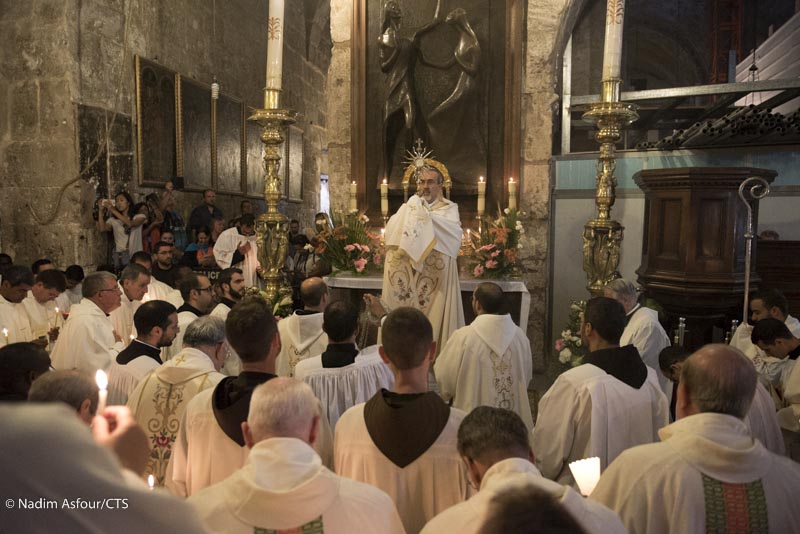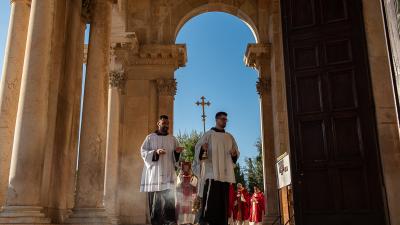
Sixty days after Easter and two weeks after Pentecost, it is once again time for a feast: the solemnity of Corpus Christi celebrates the true presence of Jesus Christ in the Sacrament of the Eucharist. In Jerusalem, the celebrations began the day before at the Basilica of the Holy Sepulcher. In the early afternoon on June 14, the Franciscans of the Custody of the Holy Land made their solemn entrance into the Church of the Resurrection, accompanied by the Apostolic Administrator of the Latin Patriarchate, Mons. Pierbattista Pizzaballa. Solemn vespers and a very well attended daily procession preceded the feast. The friars also stayed for the Compline prayer until 6 p.m. As is always the case with solemn events, while Jerusalem was fast asleep, wrapped in the darkness and silence [of the night], in the Holy Sepulcher songs of praise could be heard. These were the prayers of the vigil, which is always led by the friars of the Custody.
The next morning, a few hours later, the Basilica of the Resurrection was already full of friars and faithful for the Mass of Corpus Christi. During the Liturgy of the Word, all of the readings spoke about the true bread that fills: the word of the Lord and Jesus himself when he says, “I am the living bread that came down from heaven.”
In his homily, the Apostolic Administrator, Mons. Pierbattista Pizzaballa recalled the feast of the Most Holy Trinity, which just passed, saying that in order to enter into the understanding of that mystery, no language other than love can be used. “The Solemnity of Corpus Christi makes us take a step beyond, and tells us something about how God loves,” Pizzaballa said. This “how” happens through his Body.” The Bishop emphasized Jesus’ humanity and the gift that it is for us: “It is with this Body that Jesus loved those whom he met, got close to people, looked at them and saw them, felt compassion for them, touched them and let [them] touch [him]; he felt hungry and thirsty, tired and afraid; he walked with people, sat at the table, experienced tenderness and anger. He prayed to the Father. This Body, wherever it went, healed and saved.”
A powerfully emotional atmosphere accompanied the procession, which after the mass, made its way around the Edicule three times, thus around Jesus’ tomb, where he offered his body to the world, where by his sacrifice he gave salvation. In the procession, first came the Kawas, the guardians of honor in Turkish garb, who opened up the path with their sticks, then the priests of the Latin Patriarchate and the friars, and finally Mons. Pizzaballa, who carried the Blessed Sacrament. Behind him, the faithful followed with the booklets in hand in order to sing eucharistic songs. Pange lingua, Tamtum ergo sacramentum: all songs devoted to Christ, present in the sacrament of the Eucharist.
After the procession, a pilgrim tried to explain the reason for her emotion: “I cried because I thought of what Jesus did for me. And today I am full of joy.”
Beatrice Guarrera




